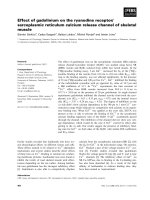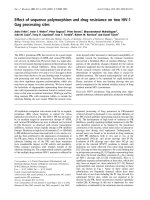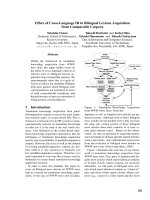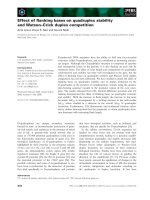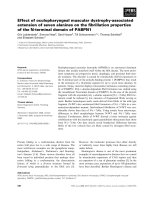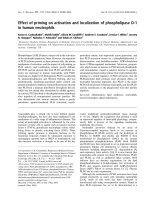Báo cáo khoa học: "Effect of trikatu pretreatment on the pharmacokinetics of pefloxacin administered orally in mountain Gaddi goats" docx
Bạn đang xem bản rút gọn của tài liệu. Xem và tải ngay bản đầy đủ của tài liệu tại đây (260.95 KB, 5 trang )
JOURNAL OF
Veterinary
Science
J. Vet. Sci. (2008), 9(1), 25
29
*Corresponding author
Tel: +91-1894-230368; Fax+91-1894-230327
E-mail:
Effect of trikatu pretreatment on the pharmacokinetics of pefloxacin
administered orally in mountain Gaddi goats
Madhukar S. Dama
1
, C. Varshneya
1,
*
, M. S. Dardi
2
, V. C. Katoch
3
1
Department of Pharmacology and Toxicology, College of Veterinary and Animal Sciences, CSK Himachal Pradesh
Agricultural University, Palampur-176 062, Himachal Pradesh, India
2
Krishi Vigyan Kendra, CSK HPAU, Mandi at Sunder Nagar Distt Mandi, Himachal Pradesh, India
3
Department of Veterinary Microbiology, CSK Himachal Pradesh Agricultural University, Palampur-176 062, Himachal
Pradesh, India
The pharmacokinetics of orally administered pefloxacin
were studied to evaluate the bio-enhancing effect of the
herbal bio-enhancer, trikatu, in mountain Gaddi goats
(n = 6). The findings of the study revealed a decreased
plasma concentration (p > 0.05) of pefloxacin following
trikatu administration during the absorption phase (10,
15, 20 min post pefloxacin administration). In contrast, the
plasma concentrations of pefloxacin were significantly
higher at 4, 6, 8 and 12 h (during the elimination phase) of
the pefloxacin administration. The findings of the inve-
stigation revealed higher values for the area under the
curve, the area under the first moment of the plasma drug
concentration time curve, the mean residential time, the
total duration of pharmacological action and bioavaila-
bility. Trikatu treatment, however, significantly reduced the
elimination half life (t
1/2
β
) and zero time intercept of the
elimination phase. The apparent volume of distribution
based on the total area under the plasma drug concentration
curve [(Vd
(area)
] and the apparent volume of distribution
based on the zero time plasma concentration intercept of
the elimination phase [Vd
(B)
] were significantly higher in
trikatu treated animals indicating a better penetration of
the drug. Based on the MIC of 0.8
µ
g/ml of pefloxacin, a
priming dose of 6.0 mg/kg and a maintenance dose of 2.21
mg/kg is required to be administered at 8 h intervals. For
practical purposes in goats this would mean a priming
dose of 6 mg/kg and a maintenance dose of 2 mg/kg given
by the oral route, to be repeated at 8 h intervals.
Keywords: goats, oral administration, pefloxacin, pharmaco-
kinetics, trikatu
Introduction
Fluoroquinolones are now becoming the antibacterials of
choice in veterinary therapeutics. The fluoroquinolones
have also become popular as there are minimal chances of
bacterial resistance with these agents. The pharmaco-
kinetics of pefloxacin are clearly described in various
species [1,8,10,15]. Inspection of the pharmacokinetic
behavior in various animal species reveals that the drug is
poorly absorbed in goats following its oral administration.
One practical approach to enhance the bioavailability is by
using herbal bio-enhancers with the antibacterial agents.
Piper longum pretreatment has been successfully employed
as a bio-enhancer with orally administered oxytetracycline
in WLH poultry birds [7]. In the present study, the effect of
the herbal bio-enhancer, trikatu (equal parts of Piper
longum, Piper nigrum and Zingiber officinale) on the
pharmacokinetic behaviour of pefloxacin in mountain
Gaddi goats is presented.
Materials and Methods
The study was conducted on six adult healthy mountain
Gaddi goats weighing 18-22 kg. The same animals were
used for both treatments after a wash out period of 15 days.
The goats were kept under close observation before
beginning the experiments to enable them to acclimatize to
the new environment. In the first treatment pefloxacin
(Pelwin; Wokhardt, India) was given at the dose rate of 20
mg/kg body weight whereas in second treatment animals
were orally administered trikatu (piperine contents of
trikatu 2.02% (w/w)) at a dose rate of 2 g/kg for 14 days and
on day 15, pefloxacin was administered at the dose rate of
20 mg/kg. 5 ml blood samples were collected from each
animal in heparinized tubes at 10, 15, 20, 30, 45, 60, 120,
240, 360, 480 and 720 min post drug administration and
were centrifuged at 3,000 rpm for 10 min for plasma
26 Madhukar S. Dama et al.
Table 1. Comparative pharmacokinetic profile of pefloxacin
administered orally (20 mg/kg) in control and trikatu treated
goats (mean ± SE)
Parameter
#
Unit Control Trikatu treated
Ka
A
β
B
t
1/2Ka
t
1/2
β
AUC
AUMC
Vd
(area)
Vd
(B)
Cl
B
MRT
t
d
F
/h
µg/ml
/h
µg/ml
/h
/h
µg/ml.h
µg/ml.h
2
l/kg
l/kg
l/kg/h
h
h
%
2.20 ± 0.09
9.06 ± 0.13
0.26 ± 0
8.23 ± 0.1
0.32 ± 0.01
2.5 ± 0.12
27.10 ± 0.38
121.10 ± 4.07
1.11 ± 0.08
2.43 ± 0.03
0.29 ± 0.02
4.47 ± 0.16
19.72 ± 0.38
38.83 ± 1.8
2.18 ± 0.15
7.96 ± 0.42
0.21 ± 0.01**
7.30 ± 0.19**
0.32 ± 0.02
3.30 ±0.19**
30.85 ±1.39**
164.25± 15.62*
1.37 ± 0.11*
2.75 ± 0.08*
0.29 ± 0.02
5.27 ± 0.27*
24.16 ± 1.46*
44.18 ± 2.90*
#
Pharmacokinetic parameters as described by Gibaldi and Perrier [5],
K
a
: absorption rate constant, A: zero time plasma drug concentration
intercept of regression line of absorption phase, β: overall eliminatio
n
rate constant, B: zero time intercept of the regression line of the
elimination phase, t
1/2Ka
: absorption half life, t
1/2β
: elimination hal
f
life, AUC: area under the curve, AUMC: area under the first momen
t
of the plasma drug concentration time curve, MRT: mean residential
time, td: total duration of pharmacological action, Cl
B
: total
b
ody
clearance; Vd
(area)
: volume of distribution based on the total area unde
r
the plasma drug concentration time curve; Vd
(B)
: volume o
f
distribution based on the zero time plasma drug concentration
intercept of the elimination phase. *p ≤ 0.05, **p ≤ 0.01.
Fig. 1. Comparative semilogarithmic plot of plasma concen-
tration - time profile of pefloxacin in control and trikatu treate
d
goats following oral administration (20 mg/kg).
separation. The plasma samples were stored at 20
o
C for
microbial assay. The assay was completed within 1 week.
The concentration of microbiologically active pefloxacin
(parent & metabolites) in plasma were determined by the
agar plate diffusion method [4] using E. coli (strain
MTCC-443) as the test organism with the modification that
large petri plates were used instead of large glass plates and
only three punches were made for the microbial assay.
The plasma concentration-time profile of pefloxacin for
each goat was used to determine the pharmacokinetics.
Different pharmacokinetic parameters were analysed using
the “method of least square” and the “method of residual
yields” as described by Gibaldi and Perrier [5]. Estimation
of the area under the concentration- time curve (AUC) and
the area under the first moment of the plasma drug concen-
tration time curve (AUMC) were based on the trapezoidal
rule [5]. The compartmental analysis of plasma concentration
vs. time was carried out using the mono-exponential
equation:
Cp
(t)
= Be
- βt
- Ae
-Kat
Where Cp
(t)
is the plasma drug concentration at time t, B
is the zero time intercept of the regression line of the
elimination phase, A is the zero time plasma drug con-
centration intercept of the regression line of the absorption
phase, Ka is the absorption rate constant, β is the overall
elimination rate constant, t is time and e is the natural
logarithm base.
The dosage regimen for maintaining MIC of 0.1-0.8 µg/ml
for most organisms [13] at dosage interval of 4, 6 and 8 h
was derived as per the method described by Notari [11].
The difference between the means of the two treatments
was determined by student's t-test [14] and the data were
analyzed using GraphPad Instat (GraphPad Software,
USA).
Results
The results of the study revealed that the mean plasma
concentrations of pefloxacin were consistently lower in
trikatu treated goats up to 2 h. The values were
significantly lower at 10 min, 15 min and 20 min post drug
administration (Table 1 and Fig. 1). The values at 20 min
post drug administration were 3.17 µg/ml in control animals
Effect of trikatu on pefloxacin pharmacokinetics 27
Table 2. Dosage regimen of pefloxacin, calculated on the basis of pharmacokinetic values obtained following its oral administration
(with and without trikatu treatment) in goats at dosage intervals for micro-organisms of different susceptibilities
Microorganism
susceptibility
Dosage interval
4 h 6 h 8 h
Control Trikatu treated Control Trikatu treated Control Trikatu treated
0.1*
0.2
0.3
0.4
0.6
0.8
0.31
†‡
(0.11)
0.62
(0.23)
0.93
(0.34)
1.24
(0.45)
1.86
(0.68)
2.49
(0.91)
0.32
(0.12)
0.64
(0.23)
0.96
(0.35)
1.28
(0.47)
1.92
(0.70)
2.56
(0.94)
0.52
(0.19)
1.04
(0.38)
1.57
(0.57)
2.09
(0.77)
3.14
(1.15)
4.18
(1.54)
0.49
(0.18)
0.98
(0.36)
1.47
(0.54)
1.96
(0.72)
2.94
(1.08)
3.92
(1.44)
0.88
(0.32)
1.76
(0.65)
2.64
(0.97)
3.52
(1.29)
5.28
(1.94)
7.04
(2.59)
0.75
(0.27)
1.50
(0.55)
2.25
0.83
3.0
(1.10)
4.5
(1.65)
6.0
(2.21)
*Values are expressed as µg/ml.
†
Values given are expressed as mg/kg body weight.
‡
Values given are loading doses and the values in paren-
thesis are maintenance doses.
against 2.87 µg/ ml in trikatu treated goats. In contrast, the
plasma concentrations of pefloxacin were significantly
higher at 4, 6, 8 and 12 h post pefloxacin administration.
The plasma levels were 1.28 µg/ml in trikatu treated
animals at 8 h whereas the plasma levels were 1.07 µg/ml
in control animals.
The values of the pharmacokinetic determinants in the
control and trikatu treated animals are given in Table 2.
The values of the absorption rate constant (K
a
) and zero
time intercept of the absorption phase (A
1
) revealed a non
significant difference between the two groups.
The findings of the present study further revealed
significantly higher values ( 30.85 ± 1.39 µg/ml.h in trikatu
treated animals against 27.10 µg/ml.h in control animals)
for the area under curve (AUC), AUMC, the mean residen-
tial time (MRT) and the total duration of pharmacological
action (t
d
) in the trikatu treated goats. The mean residential
time was 5.27 ± 0.27 h in trikatu treated animals against
4.47 ± 0.16 h in control animals. Similarly, the total
duration of the td was 24.16 ± 1.46 h in trikatu treated
animals against 19.72 ± 0.38 h in control animals. The
bioavailability of the drug was also significantly higher (p
< 0.05) in trikatu treated goats (44.18 ± 2.90% against
38.33 ± 1.80% in control animals).
Prior treatment of the goats with trikatu significantly
reduced the elimination half life (t
1/2β
) and the zero time
intercept of the elimination phase (B). The elimination half
life was 3.30 ± 0.19 /h in trikatu treated against 2.5 ± 0.12
/h in control animals. The total body clearance (Cl
B
),
however, did not show any significant difference in the
trikatu treated goats.
The indicators of drug distribution in the body i.e.
apparent volume of distribution [Vd
(area)
] and volume of
distribution based on the zero time plasma drug concen-
tration intercept of the elimination phase [Vd
(B)
] were
significantly higher in the trikatu treated goats. The values
of Vd
(area)
in trikatu treated goats were 1.37 ± 0.11 l/kg
whereas the values of Vd
(area)
were 1.11 ± 0.08 l/kg in
control animals.
The oral priming and maintenance doses of pefloxacin
based on the minimum inhibitory concentration (MIC) of
0.1, 0.2, 0.3, 0.4 and 0.6 and 0.8 µg/ml for most of the
organisms of clinical significance in the control and trikatu
treated goats are given in Table-2. On the basis of the data
for microorganisms possessing a minimum inhibitory
concentration of 0.8 µg/ml, the priming dose of 7.0 mg/kg
and maintenance dose of 2.59 mg/kg should be repeated at
8 h intervals. However, following trikatu administration
the oral priming and maintenance doses would be 6.0 and
2.21 mg/kg, respectively and for practical purposes a
priming dose of 6.0 mg/kg and maintenance dose of 2.0
mg/kg would be required to be administered following
trikatu co-administration.
Discussion
Pefloxacin has excellent activity against a wide range of
gram positive and gram negative microorganisms and it is
28 Madhukar S. Dama et al.
being successfully used in the treatment of various human
and animal diseases. Pefloxacin is partially metabolized in
the liver to norfloxacin, which is a potent anti microbial
agent [10]. Due to its favourable pharmacokinetic proper-
ties such as better bioavailability, better volume of distri-
bution and minimal chances of resistance, it is one of the
favoured anti bacterial agents for treatment of animal
diseases. The irregular absorption from the gastrointestinal
tract of goats limits its therapeutic utility. In goats only
about 42% of the drug administered orally is available to
the systemic circulation [8].
Trikatu is an ayurvedic preparation containing an equal
ratio of long pepper (Piper longum), black pepper (Piper
nigrum) and ginger (Zingiber officinale). Piperine (1-piperoyl
piperidine), an amide alkaloid, from a different species of
pepper is mainly responsible for enhancing the bioavailability
of concurrently administered drugs [3,7,9]. Ginger in the
preparation, may also aid the absorption of drugs through
thermogenesis.
The observed plasma values of pefloxacin in goats by oral
route were best described by a one compartment model.
This model has also been used by previous workers to
describe the pharmacokinetics of pefloxacin in various
domestic species [8]. The findings of the present study
indicated that plasma concentrations of the drug remained
lower up to 2 h post drug administration with consistently
significantly lower concentrations up to 20 min. In contrast,
in our earlier studies in birds [7], higher plasma values of
oxytetracycline were observed following Piper longum
treatment during the absorption phase. The findings of the
present study in goats therefore ruled out the possibility of
vasodilatation of enteric vessels [2] during absorption. The
findings of the present study agreed with those of Lala et al.
[6] who also observed decreased plasma levels of declo-
fenac sodium during the absorption phase in rabbits.
The decreased elimination of the drug was adequately
supported by the higher values of t
1/2β
in the present study.
However, the total body clearance (Cl
B
) remained unaffected
in the trikatu treated goats. Further, higher values of the
apparent volume of distribution values based on the
apparent volume of distribution based on the total area
under the plasma drug concentration time curve [Vd
(area)
]
indicated a better penetration of the drug in various body
tissues. This was supported by the higher value for the
apparent volume of distribution based on the zero time
plasma concentration intercept of elimination phase
[Vd
(B)
] The higher values of AUC, AUMC, and MRT in the
piperine treated goats were indicative of enhanced
systemic availability of pefloxacin following trikatu admi-
nistration.
The pharmacokinetic profile of pefloxacin following
trikatu administration revealed an enhancement of bioa-
vailability. The enhanced bioavailability was not due to
increased absorption but because of decreased elimination
as evidenced by the higher values of t
1/2β
. The decreased
elimination could either be due to suppression of drug
metabolizing activities [12] or due to decreased renal
excretion.
In the present study t
d
and MRT were also indicative of
enhanced systemic availability of pefloxacin in trikatu
treated goats.
Based on the MIC data, only a marginal reduction in the
dose (6-15%) was possible following trikatu admini-
stration. Nonetheless, trikatu administration enhanced the
duration of antimicrobial action by about 22%.
Acknowledgments
We express our sincere thanks to the Dean, College of
Veterinary and Animal Sciences, CSK Himachal Pradesh
Agricultural University, Palampur- 176 062 (HP) India, for
providing the necessary facilities to carry out the present
investigation.
References
1. Abd El-Aty AM, Goudah A. Some pharmacokinetic param-
eters of pefloxacin in lactating goats. Vet Res Commun 2002,
26, 553-561.
2. Annamalai AR, Manavalan R. Effects of Trikatu and its in-
dividual components and piperine on gastrointestinal tract:
Trikatu - A bioavailability enhancer. Indian Drugs 1989, 27,
595-604.
3. Atal CK. A breakthrough in drug bioavailability- a clue from
age old wisdom of Ayurveda. Indian Drug Manuf Asso Bull
1979, 10, 483-484.
4. Bennett JV, Brodie JL, Benner EJ, Kirby WM. Simplified,
accurate method for antibiotic assay of clinical specimens.
Appl Microbiol 1966, 14, 170-177.
5. Gibaldi M, Perrier D. Pharmacokinetics. 2nd ed. pp.45-109,
Marcel-Dekker, New York, 1982.
6. Lala LG, D'Mello PM, Naik SR. Pharmacokinetic and phar-
macodynamic studies on interaction of “Trikatu” with diclo-
fenac sodium. J Ethnopharmacol 2004, 91, 277-280.
7. Singh M, Varshneya C, Telang RS, Srivastava AK.
Alteration of pharmacokinetics of oxytetracycline following
oral administration of Piper longum in hens. J Vet Sci 2005,
6, 197-200.
8. Malik JK, Rao GS, Ramesh S, Muruganandan S, Tripathi
HC, Shukla DC. Pharmacokinetics of pefloxacin in goats af-
ter intravenous and oral administration. Vet Res Commun
2002, 26, 141-149.
9. Mathur P, Valpandium T, Sengupta S, Gupta SK. Effect
of piperine on analgesic activity of Nimesulide: a possible
pharmacokinetic interaction. Indian J Pharm 1998, 30, 204.
10. Montay G, Goueffon Y, Roquet F. Absorption, distribution,
metabolic fate, and elimination of pefloxacin mesylate in
mice, rats, dogs, mon keys, and humans. Antimicrob Agents
Chemother 1984, 25, 463-472.
11. Notari RE. Biopharmaceutics and clinical pharmacoki-
netics: an introduction. 4th ed. pp.221-270, Marcel-Dekker,
Effect of trikatu on pefloxacin pharmacokinetics 29
New York, 1987.
12. Reen RK, Wiebel FJ, Singh J. Piperine inhibits aflatoxin B
1
induced cytotoxicity and genotoxicity in V79 Chinese ham-
ster cells genetically engineered to express rat cytochrome
P
450
2B1. J Ethnopharmacol 1997, 58, 165-173.
13. Sharma AK, Khosla R, Kela AK, Mehta VL. Fluoroquino-
lones: Antimicrobial agents of the 90's. Indian J Pharm 1994,
26, 249-261.
14. Snedecor GW, Cochran WG. Statistical Methods. 6th ed.
pp.59-65, Iowa State University Press, Ames, 1967.
15. Srivastava AK, Dumka VK, Deol SS. Disposition kinetics
and urinary excretion of pefloxacin after intravenous in-
jection in crossbred calves. Vet Res Commun 2000, 24,
189-196.



